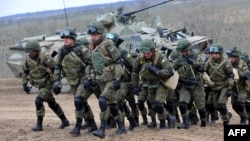Russia this week is staging war games in Siberia and the Far East that the Kremlin has described as "the largest-ever" military-training drills on Russian territory.
Moscow says the number of troops involved in Vostok-2018 from September 11-17 will more than double the troop levels seen at the largest-ever Soviet military drills -- the so-called Zapad-81 exercises in 1981 that involved up to 150,000 Soviet soldiers.
Russian Defense Minister Sergei Shoigu says Vostok-2018 will involve Russia's army, air force, and navy as well as troops from China and Mongolia.
"Taking part in it will be about 300,000 troops; more than 1,000 planes, helicopters, and drones; up to 80 combat and logistic naval vessels; and up to 36,000 tanks, armored-personnel carriers, and other vehicles," Shoigu said on September 4.
Shoigu said the "active phase" of Vostok-2018 will take place at "five general-purpose proving grounds" in central and eastern Russia, four aerospace force and air defense grounds, and three seas off Russia's Far East coast -- the Sea of Japan, the Sea of Okhotsk, and the Bering Sea.
According to Shoigu, the "main scenario" will take place at the Tsugol proving ground in the Trans-Baikal region -- part of Russia's Eastern Military District.
About 3,200 Chinese troops will train alongside Russian forces at the Tsugol ground along with 900 Chinese military vehicles and 30 aircraft.
Kremlin spokesman Dmitry Peskov says Russian President Vladimir Putin will attend the "strategic drills" after his visit to the Eastern Economic Forum in the Far East city of Vladivostok, which runs from September 11-13.
INFOGRAPHIC: Up In Arms: Russia's Massive Vostok-2018 War Games
Alex Kokcharov, a principal research analyst on Russia at the London-based risk assessment firm IHS Markit, notes that China has never before participated in Russia-organized war games on Russian soil.
"There have been joint exercises under the auspices of the Shanghai Cooperation Organization (SCO), but those were different because they were multinational,” Kokcharov told RFE/RL on September 10. "These are different because this is a Russian-run exercise with China and Mongolia invited to take part.”
"Fundamentally, the goal of this specific exercise is to project Russian military power in the Asia-Pacific region," Kokcharov explained. "If Russia had not invited China, that would have been viewed by Beijing as a potentially dangerous activity by Russia."
"I think China was invited to remove any fears from the Chinese leadership that this specific exercise is aimed at China," Kokcharov said. "This is a message not so much to China, but more to the United States and Japan."
"Russia wants to show that it has large-scale military capabilities not just in the west of the country where most of its military installations and military forces are, but also in the east -- which is much less densely populated but holds a lot of natural resources and territory," Kokcharov said.
'Not Just For The Optics'
Mark Galeotti, an external researcher on Russia for the Institute of International Relations Prague, says Vostok-2018 is meant to show the world that Russia is now able to fight a full-scale conflict involving all branches of its military forces.
"This is about training how their higher-level command structures work. But at the same time, they absolutely have a clear sense of how the rest of the world is going to look at it -- particularly with the involvement of the Chinese," Galeotti told the British Forces Broadcasting Service recently.
"You don't put up to 300,000 people in the field, or at least getting involved in an exercise, just for the optics,” Galeotti said.
But at the same time, Galeotti said, Vostok-2018 demonstrates that "Russia does have a friend" in China, and Beijing "should not be ruled out in modern geopolitics.”
Kokcharov says he doesn't look at the Vostok-2018 drills as being linked to current tensions between Moscow and the West over the wars in Syria or eastern Ukraine because the drills have probably been planned for several years.
"I wouldn't link this to Russia's military involvements in Syria or Ukraine. Logistics for this are likely to be complex and would require a lot of planning,” Kokcharov told RFE/RL. "Though these drills were announced only recently, I'm sure it was in the works and in planning for a very long period of time -- potentially since last year or even a couple of years ago."
However, Kokcharov doubts that Vostok-2018 will be as large as the Kremlin is claiming.
"Last year, when Russia carried out the Zapad-2017 exercise jointly with Belarus, the Kremlin significantly underreported the number of military personnel involved in order to avoid having to invite foreign observers," as required by the Conventional Forces in Europe (CFE) treaty.
"What Russia did last year for Zapad-2017 was to simultaneously carry out several exercises, all of which were under 13,000 people,” he said. "But overall, jointly, there were about 60,000 people involved in all of the different operations that were part of Zapad-2017."
"Considering that we know Russia seriously underreported the numbers of troops involved in Zapad-2017, I don't see why we should take Moscow's words at face value this time around when it says it's going to involve 300,000 servicemen," he said.
"Reporting the numbers as very high would send a message and get everyone spooked and worried about Russian military power in the Asia-Pacific region," he said. "In reality, there is a good possibility there would be significantly fewer people involved."
"I would say that an exercise of 60,000 people would still be a very large exercise by any standard," Kokcharov said. "But I'm not convinced that 300,000 people will be involved."

